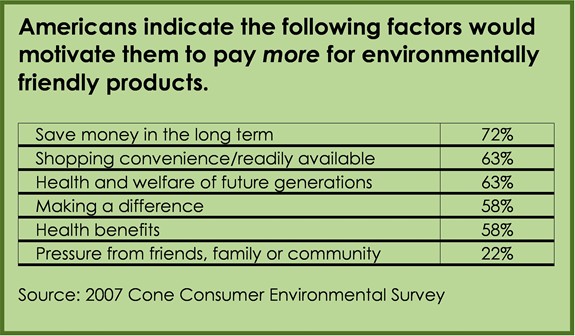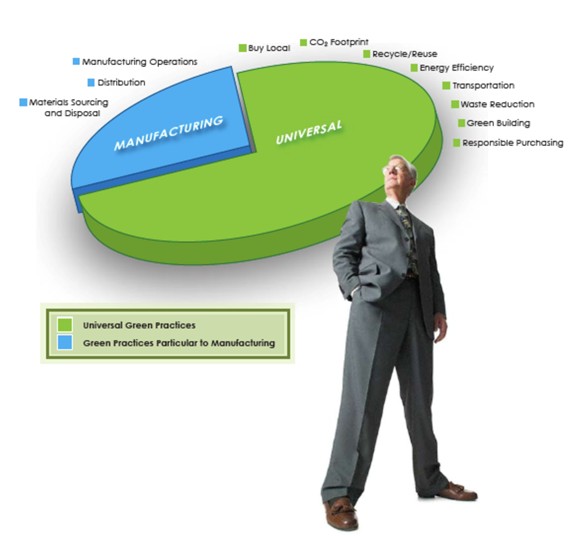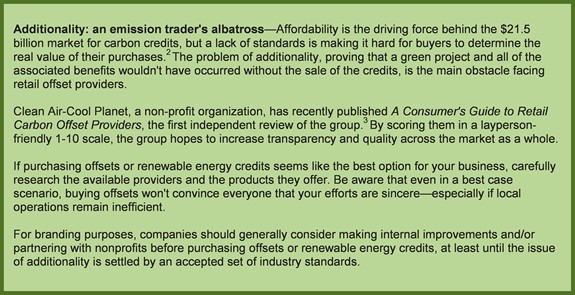Consumers are beginning to take environmental impact into consideration in purchase decisions. Businesses that demonstrate environmental responsibility have the opportunity to contribute favorably to their images while aligning themselves with their customers' wishes.
To get the full value out of green practices over time, companies need to let the public know what they are doing and why it matters.
Businesses that are becoming greener can add to their brand images by carefully selecting the right projects, telling people what they are doing, and providing easy-to-understand feedback about their progress and how the consumer contributes by doing business with them.
According to a 2007 Cone Consumer Environmental Survey, 93% of Americans believe companies have a responsibility to help preserve the environment.1

In the near future, we can expect to see an increase in the degree of mandatory baseline requirements established by government; however, consumer-led market pressures are demanding faster action.
Companies that make improvements now, while they are still voluntary, have the opportunity to brand themselves as responsible and forward thinking.
The Cone Survey also suggests that a significant portion of the public is willing to take a more active role in protecting the environment by voting with their dollars. An increasing number of traditional (for-profit) companies are responding by undertaking green initiatives, partnering with nonprofits, or finding ways to offset their emissions.
Choose the Right Project
Companies should begin by selecting projects that make sense for their business model and have value to their customers. In both manufacturing and service, initial green efforts can reduce operating costs; others will require an up-front cash commitment before payback.
Environmental responsibility is a general term that is used here to describe a broad range of causes aimed at protecting natural resources, the health of ecosystems, and life. Much of the focus at present is on reducing the negative impact of our actions as consumers and businesses. In other words, we are attempting to "reduce our footprints."
No matter which of the following three broad categories (or a combination of them) are chosen, results must be quantifiable.
1. Direct Action
Companies with opportunities for cost-effective improvements to their operations can choose to begin the greening process by cleaning up their own acts. Many businesses becoming greener choose to start with internal projects, for the following reasons:
- There is a probability of saving money by reducing energy and materials use.
- Employees and managers can be directly involved.
- It can directly improve corporate reputation.
- Doing so allows for a more resonant market message: "Look what we are doing."
The following graphic represents the array of options that companies can approach when considering the adoption of a "greener" brand positioning.

2. Piggyback
Many small and midsize businesses without an immediate plan to clean up their own operations find cooperative efforts with a nonprofit organization to be an option because it allows them to...
- Be a part of larger scale initiatives
- Piggyback on reputation and name recognition
- Make a bigger difference with a smaller budget
The Downsides:
- Someone else is doing the good deeds, not you.
- Your name can get lost in a sea of sponsors.
- Your contribution can be viewed as insignificant if it's too small relative to other supporters'.
- If the activities of your company remain environment-unfriendly, many people will interpret the message as insincere.
3. Buy Someone Else's Efforts
Companies can buy carbon offsets on the world market, but these are not broadly understood by consumers and can be perceived as a way of avoiding cleaning up one's own act.

Create Awareness
Of course, virtue is its own reward, but it doesn't generate much buzz. For your environmental efforts to contribute to your brand image, you have to tell people what you are doing and why it matters.
The growth of independent organizations that are reporting corporate environmental behavior is an indicator that the public wants to know what companies are doing or not doing. An example of a new one is Climate Counts, a nonprofit organization that scores companies based on their voluntary efforts to reverse climate change.4 Easy to understand and use, climatecounts.org is helping environment friendly consumers send a message to companies: that climate change is important to them. (Interestingly, the company will also help you send a literal message—an email to the appropriate executives at organizations).
Resources like this help conscientious companies get the recognition they deserve and make it difficult for polluters to remain anonymous, but for the moment large players get most of the spotlight.
So, if you want the market to know what you are doing, you need to actively state your commitment and show your progress. If you do not work to establish your reputation, the marketplace will assign you one.
Companies should use all effective communications tools that they can afford to spread their message. But, the message must be true and free from exaggeration. A company does not want to be condemned for greenwashing, defined by nonprofit CorporateWatch as "the phenomena of socially and environmentally destructive corporations' attempting to preserve and expand their markets or power by posing as friends of the environment."5
The best way to make sure your message is clear is to let people know results. Give them feedback.
Provide Feedback
The more clearly a business can demonstrate the impact that an individual effort makes, the more engaged and less skeptical customers become. Providing feedback to customers regarding the positive environmental impact of their involvement with your organization is absolutely critical when branding an environment-friendly product or company.
By adding an element of measurability to communications, feedback devices help customers make the transition from "XYZ Company is making a difference" to "I am making a difference."
If by using your product a consumer saves energy, water, or carbon over the "old way" or, better yet, over a competitor's product, tell them. Give them a virtual "pat on the back" and tell them how much they have contributed. Let them know that doing business with you is an easy way to help the environment.
Feedback devices work because most people don't have the time or inclination to think through the energy implications of each of their decisions. Fuel economy gauges, which help illustrate the relationship between driving style and gas mileage, and residential energy feedback devices that help families understand how their habits contribute to energy consumption, are two examples of how people change their behavior when they are given additional information.
Drivers of the Toyota Prius have responded so strongly in favor of the gas mileage gauges inside their vehicles' dashes that the automaker has developed an Eco Drive Indicator, a light that burns during efficient driving, for new models of the hybrid. Residential feedback devices have shown promise to reduce energy consumption by 10-15% by providing families with similar information.6 They also tell the consumer that they made the right purchase decision.
In marketing, feedback usually takes the form of communications rather than gauges or dials, but use the same principles. For an example, consider that many companies that previously sent paper bills through the postal system are switching to online delivery in an effort to save money in materials, printing, and postage. It also saves paper, trees, and the carbon emissions associated with printing, stuffing, and transporting tons of paper mail.
Consumers may switch to online billing for environmental or convenience reasons, but either way the company sending the bill is missing an opportunity to deliver the "pat on the back" by not giving feedback. Imagine receiving the following email from your credit card company:
As part of our company's commitment to the environment, we began offering a free online bill-pay system in 1999. You decided to participate in May 2001 and asked that we no longer send paper mail to your home. We want to say thank you. By not receiving 96 paper bills, you have personally prevented the release of 1,735 pounds of carbon dioxide into the air. Together, all MegaBank Cardholders have saved 85 Million tons and that number grows every month.
Right now, too few companies are sharing this type of information with their customers. They are missing opportunities to make a favorable impression. At present, simply undertaking some green initiatives will earn a company a temporary halo, but being green will soon no longer be news. As the market continues to move toward sustainability and brands follow suit, customers will want more than claims and statements—they will want feedback.
References/Information Sources
1 "2007 Cone Consumer Environmental Survey." Cone LLC, May 24, 2007.
2 "Voluntary Carbon Offsets Market: Outlook 2007." ICF International, 2007. Estimate by the International Emissions Trading Association and World Bank.
3 "A Consumers' Guide to Retail Carbon Offset Providers." Clean Air—Cool Planet, 2006.
4 https://www.climatecounts.org
6 "How Much Energy Are We Using? Potential of Residential Energy Demand Feedback Devices." Florida Solar Energy Center, 2006.



